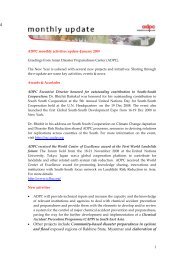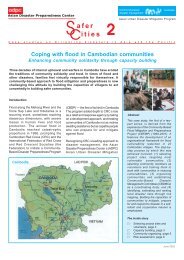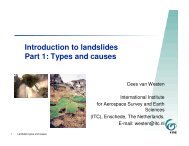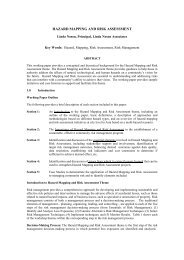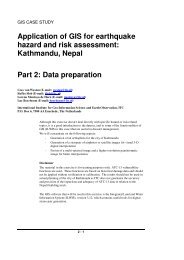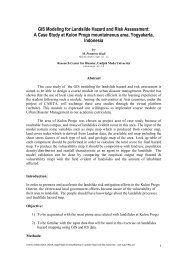community-based disaster risk management and the media media kit
community-based disaster risk management and the media media kit
community-based disaster risk management and the media media kit
Create successful ePaper yourself
Turn your PDF publications into a flip-book with our unique Google optimized e-Paper software.
chapter 1. introduction to <strong>disaster</strong> <strong>risk</strong> <strong>management</strong><br />
identifi ed <strong>the</strong> possible <strong>risk</strong>s, it is necessary to consider possible causes<br />
<strong>and</strong> scenarios, as <strong>the</strong>re are many ways an event can occur. Approaches<br />
used to identify <strong>risk</strong>s include checklists, judgments <strong>based</strong> on experience<br />
<strong>and</strong> records, fl ow charts, brainstorming, systems analysis, scenario<br />
analysis <strong>and</strong> system engineering techniques.<br />
Risk Analysis<br />
Risk analysis aims to establish an underst<strong>and</strong>ing of <strong>the</strong> level of <strong>risk</strong> <strong>and</strong><br />
its nature. It involves consideration of <strong>the</strong> sources of <strong>risk</strong>, <strong>the</strong>ir positive<br />
<strong>and</strong> negative consequences <strong>and</strong> <strong>the</strong> likelihood that those consequences<br />
may occur. Factors that affect consequences <strong>and</strong> likelihood may be<br />
identifi ed. Risk is analyzed by combining consequences <strong>and</strong> <strong>the</strong>ir<br />
likelihood. Identify <strong>the</strong> existing processes, devices or practices that<br />
act to minimize negative <strong>risk</strong>s or enhance positive <strong>risk</strong>s <strong>and</strong> assess<br />
<strong>the</strong>ir strength <strong>and</strong> weaknesses. The magnitude of consequences of an<br />
event, should it occur, <strong>and</strong> <strong>the</strong> likelihood of <strong>the</strong> event <strong>and</strong> its associated<br />
consequences, are assessed. These will be considered in <strong>the</strong> context<br />
of <strong>the</strong> existing strategies <strong>and</strong> controls. Consequences <strong>and</strong> likelihood<br />
are combined to produce a level of <strong>risk</strong>.<br />
Risk Prioritization<br />
The purpose of <strong>risk</strong> prioritization is to analyze <strong>and</strong> identify priority areas<br />
for action. Decisions may include whe<strong>the</strong>r a <strong>risk</strong> needs treatment,<br />
whe<strong>the</strong>r an activity should be undertaken, <strong>and</strong> what should be <strong>the</strong><br />
priorities for treatment. Decisions would be <strong>based</strong> on <strong>the</strong> level of <strong>risk</strong>,<br />
specifi ed consequences, <strong>the</strong> likelihood of specifi ed events or outcomes,<br />
<strong>and</strong> <strong>the</strong> overall effect of multiple events. In some circumstances, <strong>the</strong><br />
<strong>risk</strong> prioritization may lead to a decision to undertake fur<strong>the</strong>r analysis.<br />
Risk Treatment<br />
Risk prioritization provides a list of <strong>risk</strong>s requiring treatment. Risk<br />
treatment involves identifying strategies for treating <strong>the</strong>se <strong>risk</strong>s,<br />
evaluating those options, preparing treatment plans <strong>and</strong> implementing<br />
<strong>the</strong>m. Before appropriate treatment actions can be determined, <strong>the</strong><br />
analysis of each <strong>risk</strong> may need to be revisited <strong>and</strong> extended to draw<br />
out <strong>the</strong> information needed to identify <strong>and</strong> explore different treatment<br />
options. It is particularly important to identify <strong>the</strong> causes of <strong>the</strong> <strong>risk</strong>s so<br />
<strong>the</strong>se are treated <strong>and</strong> not just <strong>the</strong> symptoms. Risk treatment may itself<br />
introduce new <strong>risk</strong>s that need to be identifi ed, assessed, treated <strong>and</strong><br />
monitored.<br />
9



